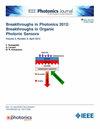硅/氧化锡异质结可调谐光电特性的实验研究
IF 2.1
4区 工程技术
Q3 ENGINEERING, ELECTRICAL & ELECTRONIC
引用次数: 0
摘要
我们报告了利用射频溅射法在 n 型硅(Si)晶片上沉积 p 型氧化锡(SnOx)并控制其生长氧压的 n-Si/p-SnOx 异质结的生长和特性分析。通过控制氧化锡的生长氧压,硅/氧化锡的异质结特性发生了变化。为了分析 n-Si/p-SnOx 异质结的结构、光学和电学特性,研究人员采用了多种表征技术,包括 PL(光致发光)、AFM(原子力显微镜)、FESEM(场发射扫描电子显微镜)、XRD、I-V 特性和霍尔测量。在正向施加偏压时,通过分析暗电流-电压(J-V)曲线的梯度,计算出膝部电压(Vknee)或切入电压。I 型、II 型和 III 型 n-Si/p-SnOx 异质结的 Vknee 值分别为 0.62 V、0.84 V 和 1.0 V。不同类型异质结的理想度系数(n1 和 n2)分别为 1.52、2.22、3.52 和 8.41、9.31、10.34。反向饱和电流密度 J01 和 J02 分别约为 10-7 至 10-6 A/cm2 和 10-5 至 10-4 A/cm2 不等。这项实验工作的目的是研究硅/金属氧化物(Si/SnOx)异质结作为光学传感器的前景,以及 SnOx 的可调光电特性。本文章由计算机程序翻译,如有差异,请以英文原文为准。
Experimental Investigation of Si/SnOx Heterojunction for Its Tunable Optoelectronic Properties
We report growth and characterization of n-Si/p-SnO
x
heterojunction using RF sputtering for deposition of p-type SnO
x
under controlled growth oxygen pressure over n-type silicon (Si) wafer. The heterojunction properties of Si/SnO
x
were varied by controlling the growth oxygen pressure of SnOx. Several characterization techniques, including PL (photoluminescence), AFM (atomic force microscopy), FESEM (field emission scanning electron microscopy), XRD, I-V characteristics and Hall measurement, were conducted to analyze the structural, optical, and electrical properties of the n-Si/p-SnOx heterojunction. The knee voltage (V
knee
), or cut-in voltage, was calculated by analyzing the gradient of the dark current-voltage (J-V) curves when the bias was applied in the forward direction. The V
knee
values for type-I, type-II, and type-III n-Si/p-SnO
x
heterojunctions were determined to be 0.62 V, 0.84 V, and 1.0 V, respectively. The ideality factors (n
1
and n
2
) were determined to be 1.52, 2.22, 3.52, and 8.41, 9.31, 10.34, respectively, for various heterojunction types. The reverse saturation current densities, J
01
and J
02
ranging from approximately 10
−7
to 10
−6
A/cm
2
, and 10
−5
to 10
−4
A/cm
2
, respectively. The objective of this experimental work is to investigate especially, the prospect of silicon /metal-oxide (Si/SnOx) based heterojunction to be used as optical sensors with tunable optoelectronic properties of SnOx.
求助全文
通过发布文献求助,成功后即可免费获取论文全文。
去求助
来源期刊

IEEE Photonics Journal
ENGINEERING, ELECTRICAL & ELECTRONIC-OPTICS
CiteScore
4.50
自引率
8.30%
发文量
489
审稿时长
1.4 months
期刊介绍:
Breakthroughs in the generation of light and in its control and utilization have given rise to the field of Photonics, a rapidly expanding area of science and technology with major technological and economic impact. Photonics integrates quantum electronics and optics to accelerate progress in the generation of novel photon sources and in their utilization in emerging applications at the micro and nano scales spanning from the far-infrared/THz to the x-ray region of the electromagnetic spectrum. IEEE Photonics Journal is an online-only journal dedicated to the rapid disclosure of top-quality peer-reviewed research at the forefront of all areas of photonics. Contributions addressing issues ranging from fundamental understanding to emerging technologies and applications are within the scope of the Journal. The Journal includes topics in: Photon sources from far infrared to X-rays, Photonics materials and engineered photonic structures, Integrated optics and optoelectronic, Ultrafast, attosecond, high field and short wavelength photonics, Biophotonics, including DNA photonics, Nanophotonics, Magnetophotonics, Fundamentals of light propagation and interaction; nonlinear effects, Optical data storage, Fiber optics and optical communications devices, systems, and technologies, Micro Opto Electro Mechanical Systems (MOEMS), Microwave photonics, Optical Sensors.
 求助内容:
求助内容: 应助结果提醒方式:
应助结果提醒方式:


